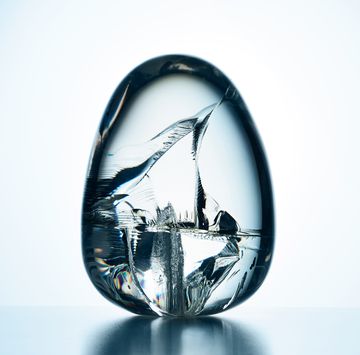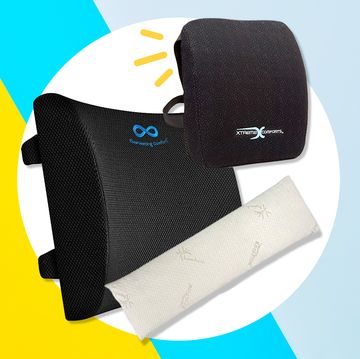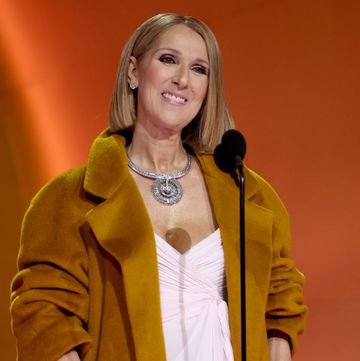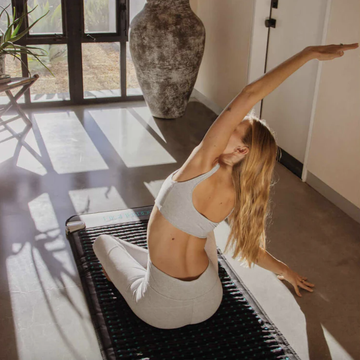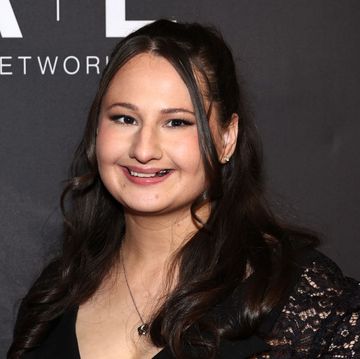People used to make fun of me for not having any boobs. In middle school, while all of my friends were graduating to underwires, I was stuck in a training bra.
It sucked. But then, the seventh grade hit, and I started growing a cup size every year—until I had ballooned to a 34I by the time I graduated college. Yes, an I. Unfortunately, boobs do come that big. And mine had.
With about eight to 10 extra pounds hanging from my chest—seriously, try strapping a kettlebell to yours and see how you do—my shoulders were perpetually hunched, my back hurt, and I felt more awkward than I had as a flat-chested middle schooler.
Bra stores constantly told me that they didn’t make bras big enough for me. Eventually, I was able to find one boutique bra store that did sell bras in my size. But they set me back 90 bucks a pop. Meanwhile, I had to buy extra-large shirts so that they would stretch over my breasts—but the rest of my body swam in the extra fabric. I hated wearing swimsuits. Really, there wasn’t anything I didn’t hate wearing. One look at me, and your eyes went straight to my breasts.
Deciding to Downsize
For two years, I debated having breast-reduction surgery. Just in case, though, I made sure to mention to my ob-gyn during every visit that I experienced back pain because of the extra weight. She documented it each time, explaining that, if I ended up deciding to get the procedure, being able to show that back pain was an ongoing problem would be vital to getting it covered by insurance.
Then, in 2009, at 22 years old, I decided it was time. I knew that breasts could grow up until around that age, so I wanted to make sure I didn’t get a reduction and then end up needing another one in five years. But at the same time, I didn’t want to wait so long that my back problems became debilitating.
RELATED: 11 Weird Facts About Your Breasts
My ob-gyn referred me to a plastic surgeon who then took a barrage of topless photos of me to send to my insurance company, along with paperwork so that, in the end, a good 98 percent of the procedure would end up being covered by insurance. My plastic surgeon explained that since the surgery would be so dramatic, I would likely need to have liposuction under my armpits—and insurance wouldn’t cover that. I ended up getting the under-arm lipo anyway.
Designing the Dream Girls
Since I—somehow ironically—worked at Victoria’s Secret for several years during high school and college, I knew that I wanted to come out of surgery with C-cupped breasts. Still, my plastic surgeon recommended that I do some recon by checking out porn sites. Seriously!
So my boyfriend, best friend, and I sat down one night and spent hours combing through porn sites. “Do you like her boobs?” “These ones are nice, but they are a little wide-set.” “I want your nipples to be bigger than hers.” The conversation was ridiculous and hilarious. We still laugh about it.
I printed off pictures of my ta-tas of choice and brought them with me to the hospital on the morning of my surgery. Sitting in the operating room waiting for things to get started, the anesthesiologist saw I was holding some paper and was like, “What’s this?” When he grabbed the paper and looked at it, his face was priceless. The page was filled with pictures of naked breasts.
Surgery, Recovery, and Sponge Baths
I was out during the entire surgery, so I can’t really say much about the procedure itself. But when I woke up, I was shocked at the time. The surgery was supposed to have taken four to five hours, but it ended up taking seven because of all of the tissue that had to be removed.
In the recovery room, I was swollen and wrapped up in gauze. Under my breasts, two drainage tubes ran beneath my skin like built-in underwires. At the ends were little plastic bags that would collect blood and puss for the next week.
I don’t usually get sick from anesthesia, but since I was under for so long, I spent the rest of the day throwing up and having the nurses give me anti-nausea meds. There was an option to have the surgery done as an outpatient procedure, but I don’t know how anyone could possibly leave the hospital a couple of hours after getting out of surgery. I stayed there for one night.
I’ve also had people tell me you can go back to a work within a week of having breast-reduction surgery. They lie.
After breast-reduction surgery, you need someone around to help you with routine tasks for at least the first week. You literally cannot lift your arms more than about six inches from your sides because those muscles are so weak. So if someone left a plate on the counter, I couldn’t reach it. Friends, family, and my boyfriend had to wash me. It took two people to get me through the shower, as I sat on a plastic shower bench. I couldn’t get the incisions or drainage tubes wet, and I couldn’t raise my arms. At night, I slept propped up and wedged between pillows so I wouldn’t roll over on my tender breasts.
After about a week, the doctor pulled out the drainage tubes, and then, a week later, he helped me get into a sports bra. I got one that had a front-zip closure, which was really helpful since I couldn’t raise my arms. I wore sports bras for the next couple of weeks until my doctor said I could start wearing underwire-free bras.
The stiches were all internal and dissolvable, so luckily I didn’t have to worry about getting them taken out at any point. Although a few did end up poking out through my skin, so I had to visit the doctor to get those removed.
RELATED: Learning Curves: All About Breast Health
My doctor also gave me jelly strips that I placed over the incisions to help prevent scarring. I wore them every day for about a year. It probably took a good year and a half to two years for the scars to fade to the point they're at now. The only scars you can still see are under my armpits from the liposuction, and they are really minimal. You can really only see them when I’m in a swimsuit.
My Life as a C Cup
Apart from deciding to marry the man that helped me pick out my new boobs, having the breast-reduction surgery was the best decision I ever made.
For one, my back pain is completely gone. Sleeping, walking around, and just living is so much more comfortable. I don’t hurt every day. And now, I can work out without enduring horrific pain. I’ve gotten really into yoga, and I can’t imagine doing half of the poses with my former I cup breasts.
But most importantly, I feel more like “me.” My breasts are part of me, rather than being what I lead with. People aren’t constantly gawking at my chest. People now see me before they see my boobs, and I feel so much more confident as a result. Plus, it’s awesome being able to wear clothes that actually fit and buy pretty, lacy, pink bras for once.
I am a little nervous about whether or not I will be able to breastfeed whenever I do decide to have children. During breast-reduction surgery, so much tissue is removed that some of the mammary glands can actually be taken out, reducing the amount of milk you can produce. Plus, the surgery can reduce nipple sensation, making getting the milk out more difficult. Luckily, the sensitivity of one of my nipples hasn’t changed since the surgery, which bodes well for my chances at breastfeeding (as well as my enjoyment of other pursuits). But in the other, the sensation is a bit wonky. If you touch my nipple, I feel it in another part of my breast. Apparently, some wires got crossed during the surgery.
RELATED: The Crazy Stuff That Happens to Your Boobs When You Have a Baby
I’m definitely glad I got the surgery, though. If you're considering a breast-reduction procedure, talk to your doctor about your concerns. Talk to others who have had the procedure about their experiences. You’d really be surprised how common it is. And more and more women are going under the knife for a reason: because it can change your life.





